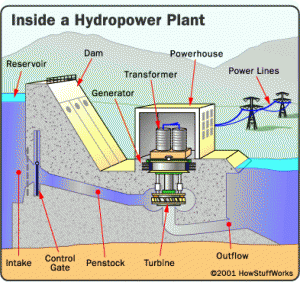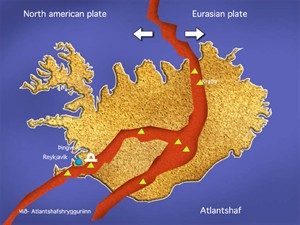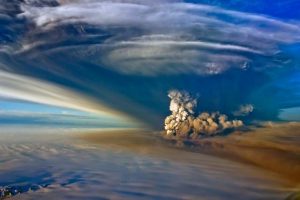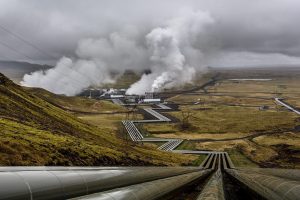Iceland is a small island in North – Atlantic between Greenland and Faroe Islands. Iceland is nearly 103,000 sqare kilometers in size and lies on the Atlantic ridge and is habitable because of a hot spot which is located under Western part of the glacier Vatnajökull. This hot spot is one of the most active in the world.
Iceland is placed on two tectonic plates, North – American plate and Eurasian plate. Iceland is the one of few country in the world where you can see with your eyes where the plates drift away from each other. This can be seen in the national park Þingvellir. The oldest part of Iceland is about 16 million years old.
There are about 30 active volcanos in Iceland today. An eruption can be expected in Iceland every five years. The worst volcanic eruptions frequently occur under glaciers which creates high ash and the like may flood. Grímsvötn is the most efficient volcano in Iceland because it is located under the western part of the glacier Vatnajökull near the hot spot. Probably one of the most famous eruptions in Iceland was in 2010 when the glacier Eyjafjallajökull erupted. A lot of ash and followed the eruption.
In Iceland there are six very large glaciers but also many small glaciers. Glaciers in Iceland are 11% of the country. The biggest glacier is Vatnajökull and it is the third biggest in the world and covers about 8% of the country. The highest mountain in Iceland is Hvannadalshnjúkur and is also in the glacier Vatnajökull. It is 2110 meters high.
Waterfalls in Iceland are many and most of them are very beautiful. The most popular waterfall in Iceland is probably the “Golden Waterfall”, Gullfoss.
There are a lot of resources in Iceland and the water is probably the most important resource. Because of the country’s location there is a lot of geothermal energy and both hot and cold water is utilized.
 The location of Iceland where cold air from the North pole and warm air from south meet causes a lot of rain or snow and heavy rainfall is common. When it rains the water in the rivers increase. There are several types of rivers in Iceland; There are fresh water rivers where the water is so clear and you can even drink directly from the rivers themselves. There are also glacier rivers that flow right from the glaciers and are extremely cold.
The location of Iceland where cold air from the North pole and warm air from south meet causes a lot of rain or snow and heavy rainfall is common. When it rains the water in the rivers increase. There are several types of rivers in Iceland; There are fresh water rivers where the water is so clear and you can even drink directly from the rivers themselves. There are also glacier rivers that flow right from the glaciers and are extremely cold.
Water, both from glacier rivers and freshwater rivers, is used for producing electricity.
When electricity is produced by hydropower, a dam is built in rivers and the water is collected. The water is then slided town a sloping tunnel to a turbine, the water makes the turbine spin and make electricity.
Most geothermal energy that is dug up from the ground is used for house heating.The steam from geothermal energy is also used to produce electricity. Geothermal energy is also used for swimming pools, for greenhouses, in fish farming, for heating streets during the winter and also for baking bread.
Fisheries is one of the most important sector in Iceland and employs over 24 thousand people in the country. Fisheries proposes a large part the standard live in Iceland. The location of Iceland is very favourable when it comes to the fishing stock. The temperature in the ocean is convenient which make the ocean nutritious. The most important fish is cod, mackerel and herring.
The fish is first caught by ships in large nets. Fishermen are often many days at sea and fish a lot before they sail back home. When they reach land the fish is transferred to the next freezing plant. There is also freezer trawlers in Iceland which can be at sea for many weeks and the catch is fully processed on board
The number of tourists in Iceland have increased over the last few years. Last year over one million tourists came to the country, most of them from USA or Britain. Most of the tourists come to see our beautiful land, the northern lights or to stay in a peaceful land. Because of the amount of tourist in the country many industries have bloomed. Many restaurants and hotels have made prospered because of it. In that way we can say that tourists are important resource.
Written by Ísabella and Óttar Már
Presentation about Iceland and resources in Iceland
References:
http://www.fa.is/deildir/Jardfraedi/JAR203/19_jardsaga_islands.pdf
http://krakkaruv.is/faersla/hvernig-vard-island-til



